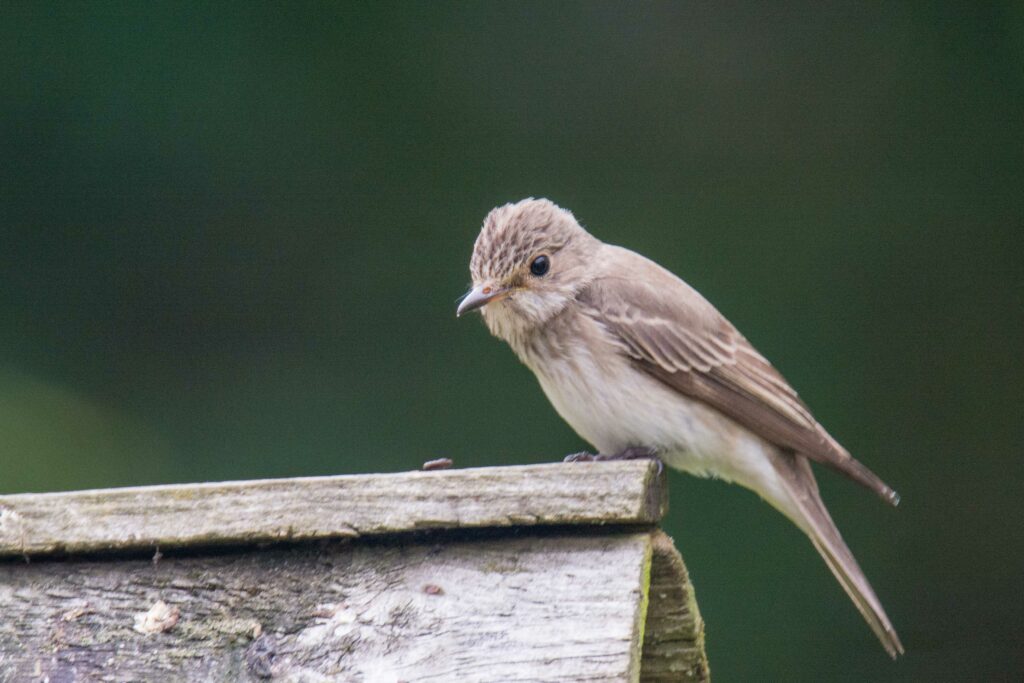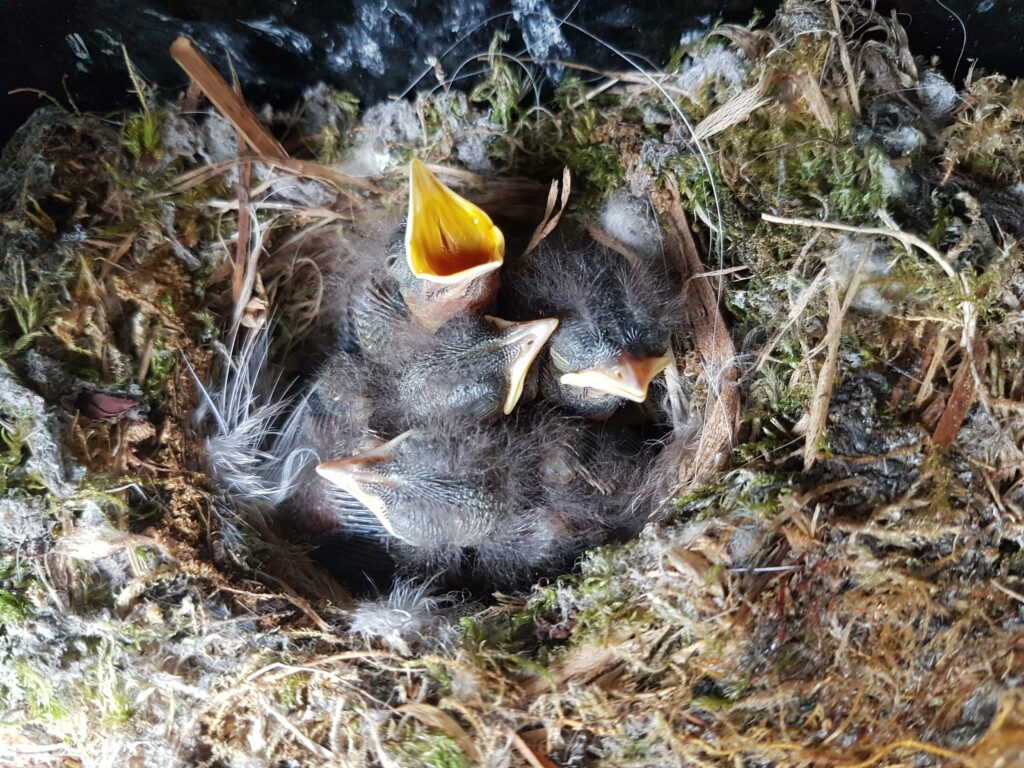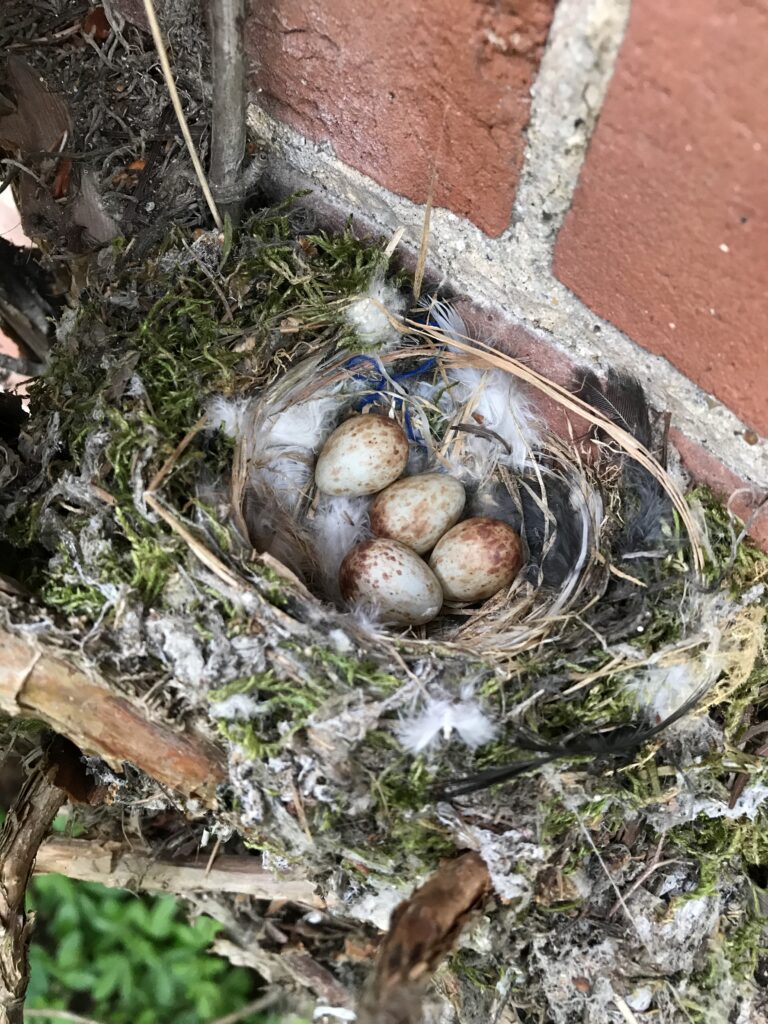Cambridgeshire update
– the 2020 breeding season
Michael Holdsworth
Our four-year BTO geolocator project finished in 2019. During the 2020 season I continued to monitor flycatchers in Cambridgeshire. My new focus has been on tracking the life-histories and survival year-to-year of individually-identifiable adult birds. I plan to continue this work in 2021, circumstances permitting.
How many pairs of flycatchers are there in Cambridgeshire?
Ninety pairs of flycatchers, in all categories (from ‘confirmed’ to ‘possible’ breeding), were recorded in 69 different Cambridgeshire tetrads (2km OS squares) in 2020. Our focus has never been to attempt a comprehensive county survey. Most of my time in 2020 was spent at

seventeen sites, mostly with multiple pairs, trying to sort out my known adults. For practical reasons, none of these study-sites was to the north of Ely – almost half the county. I also evaluated all records received via the Cambridgeshire Bird Club’s database and the BTO’s BirdTrack system. As in most years, these added only a handful of sites/pairs to my own monitoring, mainly in parts of the county I did not visit myself. Each year reveals previously unrecorded pairs, so the accumulated total is gradually growing; there were 74 pairs in all categories found in 52 tetrads in 2019. This does not of course represent an actual increase. Breeding was confirmed for 44 pairs (48 in 2019), and 30 nests were found (44).
Each year we probably record only a fraction of the flycatchers out there. Many birders go all year without seeing a flycatcher. My best guesstimate for the current Cambridgeshire population would be somewhere between 200 and 400 pairs. Many of these will be in small rarely visited woods, along rivers, or in rural gardens – undetected/unidentified/unreported by the owner.
In addition, our geolocator project had had an intrinsic bias. It had needed selectively to focus on locating suitable pairs to tag and subsequently to recapture for device retrieval. The requirements were thus to locate established pairs which would likely be site-faithful; to look for easy householder or landowner access; and most importantly to find birds which were easily catchable. This last requirement ruled out awkward woodland sites where nests might be high in trees, or where it would be impracticable to deploy mist-nets or perch-traps. As a result, little effort was directed towards finding pairs in woodland; most project pairs were thus in ‘human’ habitats – gardens, churchyards and parkland.
Where are they?
Since 2015, pairs have been recorded in 141 different Cambridgeshire 2km tetrads, but only on one single occasion in all those six years in 59 of these. In 2020 there were pairs in only 69 of these possible 141 squares. During the six years, pairs have been found in 52–69 squares each year, but with a constantly changing selection. These transient ‘pop-up’ pairs give a misleading impression when mapped as if these were a regular part of a more established population. Many probably result from random hook-ups (see below) as birds search out scarce partners.

Cambridgeshire tetrads by the highest number of years with birds present in the six years 2015-20. Fenland basin in pink. Map by Louise Bacon.
This map (Cambridge bottom right; Peterborough top left) shows in how many of the six years 2015–20 birds were found to be present (in all breeding categories). The smallest dot shows presence in just one single year (a pop-up, see above); a medium dot shows presence in two or three years; a large dot presence in four years; and a square denotes continuous presence in five or all six years – and, often, more than one pair in that tetrad.
In his 1934 Birds of Cambridgeshire David Lack wrote of flycatchers: “well distributed …. especially in the west, and rather scarce in the fen districts.” Given the limited study coverage north of Ely, the lack of records on the map above the TL80 coordinate – in the north-west (old Huntingdonshire) is unsurprising. But this also reinforces Lack’s clear association of flycatchers with higher ground and woodland. Flycatchers are largely absent from those parts of the county which are predominantly at or below sea-level within the fenland basin, shown here in pink. These are, of course, the areas which are under the most intensive arable cultivation and will have suffered the highest reductions in invertebrates. This pattern of distribution was, however, clearly apparent in the old Cambridgeshire atlases. It is more likely that flycatchers were always very scarce in Fenland, which was mainly underwater until the eighteenth century and has never had any significant woodland. Where flycatchers do occur in the Fens it is within village gardens. Ridges or fen-islands of say 10m above sea-level (Wicken, Haddenham) are all that is required to make the difference.
Ringing
In 2020 I ringed 25 new adult flycatchers and just two broods of nestlings. Since the project started, we have ringed a total of 388 nestlings and 152 adults. We have not seen or heard of any of our nestlings again. This may be because they return less faithfully to their natal area than do the adults; or it may be confirmation of the theory that one of the principal drivers of the decline is that poor survival in the first year after fledging is insufficient to recruit enough replacements into the population to offset adult mortality. The project emphasis has accordingly shifted onto adult survival. Ringing fewer nests also removes pressure on the timing and frequency of visits, since there is only a short window of opportunity in which to ring nestlings while they are neither too small nor too large. None of our adults has been encountered away from Cambridgeshire. With only two exceptions, all our re-encountered adults have returned to within a few hundred metres of where they were originally ringed. Just two, both females from single-pair sites, moved further – in each case 2.5km – presumably when their partner failed to return. If this happens regularly, then they could be many more known and returning adults (and particularly females – see below) that I am failing to re-find.

Survival and capture/recapture
For any capture/recapture project, or even just to re-sight known individual birds, the adults first must survive their round-trip migration of about 26,000km to southern Africa. Then we must locate them; and then we have to identify or catch them. An unknown proportion of birds will always survive without being re-found. Detecting rings on legs can be surprisingly difficult; birds are always very active, tend to sit on their tarsi, and – in the canopy – can often only be viewed from below, with the perch obscuring the legs.
In each of the project years a minimum of 40% of adults was recaptured or re-sighted the following year. In this respect, 2020 was typical. At my monitored sites there were 37 ‘available’ individually recognisable birds at the end of 2019 (19 males and 18 females). Out of these, 15 survived to 2020 (seven males and eight females) to give a minimum 41% return rate. The timing of early visits can be of the essence. There were a further ten birds seen briefly at sites in May, of which some, and probably most, were actually known birds which then vanished before they could be positively identified. These birds probably either had a partner which failed to return or had nests which failed early at the egg stage. Including all these would have taken the maximum survival rate above two-thirds. This is a reasonably good adult survival rate for a small long-range migrant songbird and tends to confirm the suggestion that the population decline is more a problem with birds in their first year of life/first migration.
In most years (but not in 2020), more males than females appeared to survive, but this is probably more a re-finding issue than necessarily an actual difference in survival. Most pairs are isolated from one another, and if we find flycatchers hard to find then the same must be true of the birds themselves. The sexes might react differently in the quite likely situation where a bird comes back and finds itself on its own without last year’s partner. A male will probably stay put for a while at least on the good territory he knows, singing away, hoping to attract a passing female. On the other hand, a female will quickly move on, hoping to come across a male singing somewhere else. The two female adults which we re-found at a new site some distance away were most likely widows or birds that had arrived to find their previous partner already paired.
Recent studies of bird breeding biology have focussed on the increasing phenological importance of climate change. While some migrant species are arriving and breeding earlier as a result of higher temperatures in spring, studies have shown this not to be the case with flycatchers. Recording the first egg date of a breeding attempt is generally seen as important. For flycatchers, however, on the brink of local extirpation, the main factor affecting timing may be how long it takes to find a partner; as above – males staying put and singing, females roaming. The first birds arrive in the first week of May. If quickly paired, nests can be underway and eggs laid before the end of the month, leaving plenty of time for further attempts during the season. In many cases, however, pairs were not established, or nesting started, until much later, often well into July. In these extreme cases it was impossible to establish if this was just a late hook-up, or a second attempt – either a genuine second brood following success elsewhere, or a replacement after earlier failure. Either way, late starters will certainly be limiting the number of second broods. This will impact breeding season productivity, which, along with survival, is the main driver of population decline. Some males clearly went unpaired for the whole season.

Infidelity and bad behaviour
There must be pressure on a returning adult not to hang around waiting too long for last-year’s partner if the latter is late arriving – and thus presumed dead. The evidence is that birds grab the first possible mate available.
Here are two case-studies. In one case, female A partnered male B in 2016. Female A returned early the next year, 2017, and was immediately joined by a new male C and started nesting. A week or so later we found male B nearby, also with a different and new partner D. In 2018 both A and B arrived almost at the same time and renewed their partnership. Neither bird was refound for certain in 2019 or 2020, although the territory was probably occupied.
In a second case, female A partnered male B in 2016 in a small churchyard territory. The next year, 2017, she was paired with a new partner male C. Then, in 2018, male B was back with a new partner female D, with no sign of female A anywhere nearby. The following year, 2019, female A was back with 2017’s male C. In 2020, female A was back again, paired again with male C, but with a new male E hanging around. But for her second brood female A, now at least six years old, paired up with newcomer E. Since this was a project site, the area within a kilometre of the site had been thoroughly searched on at least a dozen occasions each year but nearby gardens could easily have concealed additional pairings.
The project did not allow for any nests to be watched in any great detail. At sites where more than just a single pair was present there were a number of relationship variants which may or may not have been the result of the species’ very thin distribution. After all, the literature records all flavours of polygamy, so some of this is probably quite normal. We have seen several cases of males attending two females and their nests; and four cases of a third bird (all males?) attending and feeding at a nest. Could this be cooperative breeding by a relative? Pair-bonds sometimes changed for second broods.
The most common deviation was for a male simply to disappear during incubation and to play no further part in provisioning the female or young. Most of the time these single mothers seemed to manage fine, but we had at least three cases of females going missing, presumed dead, with young in the nest. Summer is the time of year with the greastest mortality in most species, and breeding causes obvious additional stress to females. Some deaths, of both sexes, were clearly weather related, after very cold, wet and windy spells in June, but we also recorded deaths from window-strikes (two), and traffic (one). One female was found dead brooding on her active nest. We had one case where it looked as if the male was provisioning a nest on his own; fledging in this case was successful.
